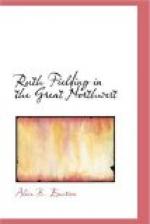“You wouldn’t ever suspect she was a Red Indian unless you looked at her,” Aunt Alvirah confessed to the rest of the family. “She’s a very nice girl.”
As for Wonota, she said:
“I used to sit beside my grandmother and work like this. Yes, Chief Totantora taught me to shoot and paddle a canoe, and to do many other things out-of-doors. But my grandmother was the head woman of our tribe, and her beadwork and dyed porcupine-quill work was the finest you ever saw, Ruth Fielding. I was sorry to leave my war-bag with Dakota Joe. It had in it many keepsakes my grandmother gave me before she passed to the Land of the Spirits.”
A demand had been made upon the proprietor of the Wild West Show for Wonota’s possessions, but the man had refused to give them up. The girl had not brought away with her even the rifle she had used so successfully in the show. But her pony, West Wind, was stabled in the Red Mill barn. Indeed, Uncle Jabez had begun to hint that the animal was “eating its head off.” The miller could not help showing what Aunt Alvirah called “his stingy streak” in spite of the fact that he truly was interested in the Indian maid and liked her.
“That redskin gal,” he confessed in private to Ruth, “is a pretty shrewd and sensible gal. She got to telling me the other day how her folks ground grist in a stone pan, or the like, using a hard-wood club to pound it with. Right slow process of makin’ flour or meal, I do allow.
“But what do you think she said when I put that up to her—about it’s being a slow job?” and the miller chuckled. “Why, she told me that all her folks had was time, and they’d got to spend it somehow. They’d better be grinding corn by hand than making war on their neighbors or the whites, like they used to. She ain’t so slow.”
Ruth quite agreed with this. The Osage maiden was more than ordinarily intelligent, and she began to take a deep interest in the development of the story that Ruth was making for screen use.
“Am I to be that girl?” she asked doubtfully. “How can I play that I am in love when I have never seen a man I cared for—in that way?”
“Can’t you imagine admiring a nice young man?” asked Ruth in return.
“Not a white man like this one in your story,” Wonota said soberly. “It should be that he did more for himself—that he was more of a—a brave. We Indians do not expect our men to be saved from disgrace by women. Squaws are not counted of great value among the possessions of a chief.”
“So you could not really respect such a man as I describe here if he allowed a girl to help him?” Ruth asked reflectively, for Wonota’s criticism was giving her some thought.
“He should not be such a man—to need the help of a squaw,” declared the Indian maid confidently. “But, of course, it does not matter if only palefaces are to see the picture.”
But Ruth could not get the thought out of her mind. It might be that the Indian girl had suggested a real fault in the play she was making, and she took Mr. Hammond into her confidence about it when she sent him the first draft of the story. Her whole idea of the principal male character in “Brighteyes” might need recasting, and she awaited the picture producer’s verdict with some misgiving.




